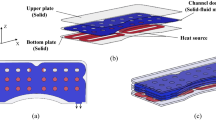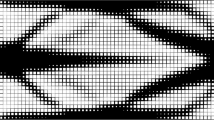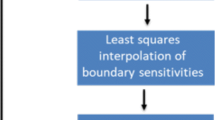Abstract
This paper investigates the topology optimization of planar cooling channels using a low-cost multilayer thermofluid model. A novel three-layer model including the upper/lower cover-plate layers and the central solid-fluid mixing layer is proposed. The flow boundary layer effect and the heat transfer effect in the thickness direction are modeled as the flow coupling and thermal coupling effects between adjacent layers, respectively. Particularly, in order to estimate more accurate temperature fields, the constructed three-layer heat transfer model in the solid-fluid mixing channel is derived based on the assumption of adaptive temperature profiles in the thickness direction. Further, based on the three-layer thermofluid model, the porosity field is introduced to describe the channel’s topology, and the corresponding topology optimization scheme is presented. Several optimized channels under different constraints and boundary conditions are shown and discussed in comparison. Optimized channels show streamlined boundaries and reasonable layouts and exhibit competitive heat dissipation performance. Parametric studies are conducted to analyze the effectiveness and reliability of the topology optimization scheme. Further, to evaluate the accuracy and efficiency of the proposed three-layer model, optimized channels are simulated with the full 3D model and previous low-cost models. The proposed three-layer model exhibits good consistency with the full 3D model while achieves great improvement in efficiency.



















Similar content being viewed by others
References
Ahmed HE, Ahmed MI (2015) Optimum thermal design of triangular, trapezoidal and rectangular grooved microchannel heat sinks. Int Commun Heat Mass Transf. https://doi.org/10.1016/j.icheatmasstransfer.2015.05.009
Alexandersen J (2011) Topology optimization for convection problems. Dissertation, Technical University of Denmark
Alexandersen J, Andreasen CS (2020) A review of topology optimisation for fluid-based problems. Fluids 5(1):29
Alexandersen J, Aage N, Andreasen CS, Sigmund O (2014) Topology optimisation for natural convection problems. Int J Numer Methods Fluids. https://doi.org/10.1002/fld.3954
Alexandersen J, Sigmund O, Aage N (2016) Large scale three-dimensional topology optimisation of heat sinks cooled by natural convection. Int J Heat Mass Transf. https://doi.org/10.1016/j.ijheatmasstransfer.2016.05.013
Asmussen J, Alexandersen J, Sigmund O, Andreasen CS (2019) A “poor man’s” approach to topology optimization of natural convection problems. Struct Multidiscip Optim 59. https://doi.org/10.1007/s00158-019-02215-9
Bendsøe MP, Sigmund O (1999) Material interpolation schemes in topology optimization. Arch Appl Mech 69:635–654. https://doi.org/10.1007/s004190050248
Bendsøe MP, Sigmund O (2003) Topology optimization: theory, methods, and applications. Springer, Berlin
Borrvall T, Petersson J (2003) Topology optimization of fluids in Stokes flow. Int J Numer Methods Fluids. https://doi.org/10.1002/fld.426
Bruns TE (2007) Topology optimization of convection-dominated, steady-state heat transfer problems. Int J Heat Mass Transf 50. https://doi.org/10.1016/j.ijheatmasstransfer.2007.01.039
Coffin P, Maute K (2016) Level set topology optimization of cooling and heating devices using a simplified convection model. Struct Multidiscip Optim. https://doi.org/10.1007/s00158-015-1343-8
Dbouk T (2017) A review about the engineering design of optimal heat transfer systems using topology optimization. Appl Therm Eng 112:841–854
Dede E (2009) Multiphysics topology optimization of heat transfer and fluid flow systems. In: Proceedings of the COMSOL users conference
Dede EM (2012) Optimization and design of a multipass branching microchannel heat sink for electronics cooling. J Electron Packag Trans ASME. https://doi.org/10.1115/1.4007159
Dede EM, Joshi SN, Zhou F (2015) Topology optimization, additive layer manufacturing, and experimental testing of an air-cooled heat sink. J Mech Des Trans ASME. https://doi.org/10.1115/1.4030989
Dilgen SB, Dilgen CB, Fuhrman DR et al (2018) Density based topology optimization of turbulent flow heat transfer systems. Struct Multidiscip Optim. https://doi.org/10.1007/s00158-018-1967-6
Duplain E, Baliga BR (2009) Computational optimization of the thermal performance of internally finned ducts. Int J Heat Mass Transf. https://doi.org/10.1016/j.ijheatmasstransfer.2009.03.030
Fabbri G (2004) Effect of viscous dissipation on the optimization of the heat transfer in internally finned tubes. Int J Heat Mass Transf. https://doi.org/10.1016/j.ijheatmasstransfer.2004.03.007
Garimella SV, Fleischer AS, Murthy JY et al (2008) Thermal challenges in next-generation electronic systems. IEEE Trans Components Packag Technol. https://doi.org/10.1109/TCAPT.2008.2001197
Gong L, Zhao J, Huang S (2015) Numerical study on layout of micro-channel heat sink for thermal management of electronic devices. Appl Therm Eng. https://doi.org/10.1016/j.applthermaleng.2014.09.048
Grujicic M, Zhao CL, Dusel EC (2005) The effect of thermal contact resistance on heat management in the electronic packaging. Appl Surf Sci. https://doi.org/10.1016/j.apsusc.2004.11.030
Haertel JHK, Nellis GF (2017) A fully developed flow thermofluid model for topology optimization of 3D-printed air-cooled heat exchangers. Appl Therm Eng. https://doi.org/10.1016/j.applthermaleng.2017.03.030
Haertel JHK, Engelbrecht K, Lazarov BS, Sigmund O (2018) Topology optimization of a pseudo 3D thermofluid heat sink model. Int J Heat Mass Transf. https://doi.org/10.1016/j.ijheatmasstransfer.2018.01.078
Jajja SA, Ali W, Ali HM, Ali AM (2014) Water cooled minichannel heat sinks for microprocessor cooling: effect of fin spacing. Appl Therm Eng. https://doi.org/10.1016/j.applthermaleng.2013.12.007
Kambampati S, Kim HA (2020) Level set topology optimization of cooling channels using the Darcy flow model. Struct Multidiscip Optim 61. https://doi.org/10.1007/s00158-019-02482-6
Kays WM (2011) Convective heat and mass transfer. Tata McGraw-Hill Education
Knight RW, Goodling JS, Hall DJ (1991) Optimal thermal design of forced convection heat sinks-analytical. J Electron Packag Trans ASME. https://doi.org/10.1115/1.2905412
Koga AA, Lopes ECC, Villa Nova HF et al (2013) Development of heat sink device by using topology optimization. Int J Heat Mass Transf. https://doi.org/10.1016/j.ijheatmasstransfer.2013.05.007
Kondoh T, Matsumori T, Kawamoto A (2012) Drag minimization and lift maximization in laminar flows via topology optimization employing simple objective function expressions based on body force integration. Struct Multidiscip Optim 45. https://doi.org/10.1007/s00158-011-0730-z
Kontoleontos EA, Papoutsis-Kiachagias EM, Zymaris AS et al (2013) Adjoint-based constrained topology optimization for viscous flows, including heat transfer. Eng Optim. https://doi.org/10.1080/0305215X.2012.717074
Lau JH (2014) Overview and outlook of three-dimensional integrated circuit packaging, three-dimensional Si integration, and three-dimensional integrated circuit integration. J Electron Packag Trans ASME. https://doi.org/10.1115/1.4028629
Lazarov BS, Sigmund O (2011) Filters in topology optimization based on Helmholtz-type differential equations. Int J Numer Methods Eng. https://doi.org/10.1002/nme.3072
Lee KS, Kim WS, Si JM (2001) Optimal shape and arrangement of staggered pins in the channel of a plate heat exchanger. Int J Heat Mass Transf. https://doi.org/10.1016/S0017-9310(00)00350-1
Lee J, Nomura T, Dede EM (2012) Design optimization of magnetic fluid cooling system. In: ASME International Mechanical Engineering Congress and Exposition, Proceedings (IMECE) 7:667–672
Manzan M, Nobile E, Pieri S, Pinto F (2008) Multi-objective optimization for problems involving convective heat transfer. In: Optimization and Computational Fluid Dynamics. Springer, Berlin. https://doi.org/10.1007/978-3-540-72153-6_8
Marck G, Nemer M, Harion JL (2013) Topology optimization of heat and mass transfer problems: laminar flow. Numer Heat Transf Part B Fundam. https://doi.org/10.1080/10407790.2013.772001
Matsumori T, Kondoh T, Kawamoto A, Nomura T (2013) Topology optimization for fluid-thermal interaction problems under constant input power. Struct Multidiscip Optim. https://doi.org/10.1007/s00158-013-0887-8
McConnell C, Pingen G (2012) Multi-layer, pseudo 3d thermal topology optimization of heat sinks. In: ASME international mechanical engineering congress and exposition, proceedings (IMECE). https://doi.org/10.1115/IMECE2012-93093
McGlen RJ, Jachuck R, Lin S (2004) Integrated thermal management techniques for high power electronic devices. Appl Therm Eng 24:1143–1156. https://doi.org/10.1016/j.applthermaleng.2003.12.029
Moradikazerouni A, Afrand M, Alsarraf J et al (2019) Comparison of the effect of five different entrance channel shapes of a micro-channel heat sink in forced convection with application to cooling a supercomputer circuit board. Appl Therm Eng. https://doi.org/10.1016/j.applthermaleng.2019.01.051
Muñoz DA, Arango JP, González C, et al (2018) Topology optimization applied to the design of cooling channels for plastic injection. In: Journal of Physics: Conference Series. https://doi.org/10.1088/1742-6596/1002/1/012004
Nørgaard S, Sigmund O, Lazarov B (2016) Topology optimization of unsteady flow problems using the lattice Boltzmann method. J Comput Phys. https://doi.org/10.1016/j.jcp.2015.12.023
Olesen LH, Okkels F, Bruus H (2006) A high-level programming-language implementation of topology optimization applied to steady-state Navier-Stokes flow. Int J Numer Methods Eng. https://doi.org/10.1002/nme.1468
Park K, Oh PK, Lim HJ (2006) The application of the CFD and Kriging method to an optimization of heat sink. Int J Heat Mass Transf. https://doi.org/10.1016/j.ijheatmasstransfer.2006.03.009
Pietropaoli M, Ahlfeld R, Montomoli F et al (2017) Design for additive Manufacturing: Internal Channel Optimization. J Eng Gas Turbines Power. https://doi.org/10.1115/1.4036358
Pollini N, Sigmund O, Andreasen CS, Alexandersen J (2020) A “poor man’s” approach for high-resolution three-dimensional topology design for natural convection problems. Adv Eng Softw 140. https://doi.org/10.1016/j.advengsoft.2019.102736
Qian S, Wang W, Ge C et al (2018) Topology optimization of fluid flow channel in cold plate for active phased array antenna. Struct Multidiscip Optim. https://doi.org/10.1007/s00158-017-1852-8
Sigmund O (1994) Design of material structures using topology optimization. Dissertation, Technical University of Denmark
Sigmund O, Petersson J (1998) Numerical instabilities in topology optimization: a survey on procedures dealing with checkerboards, mesh-dependencies and local minima. Struct Optim. https://doi.org/10.1007/BF01214002
Stolpe M, Svanberg K (2001a) An alternative interpolation scheme for minimum compliance topology optimization. Struct Multidiscip Optim. https://doi.org/10.1007/s001580100129
Stolpe M, Svanberg K (2001b) On the trajectories of penalization methods for topology optimization. Struct Multidiscip Optim 21. https://doi.org/10.1007/s001580050177
Svanberg K (1995) A globally convergent version of MMA without linesearch. In: Proceedings of the First World Congress of Structural and Multidisciplinary Optimization 28:9–16
Van Oevelen T, Baelmans M (2014) Numerical topology optimization of heat sinks. In: Proceedings of the 15th international heat transfer conference. https://doi.org/10.1615/ihtc15.opt.009168
Wang F, Lazarov BS, Sigmund O (2011) On projection methods, convergence and robust formulations in topology optimization. Struct Multidiscip Optim. https://doi.org/10.1007/s00158-010-0602-y
Xu S, Cai Y, Cheng G (2010) Volume preserving nonlinear density filter based on Heaviside functions. Struct Multidiscip Optim 41. https://doi.org/10.1007/s00158-009-0452-7
Yaji K, Yamada T, Kubo S et al (2015) A topology optimization method for a coupled thermal-fluid problem using level set boundary expressions. Int J Heat Mass Transf. https://doi.org/10.1016/j.ijheatmasstransfer.2014.11.005
Yaji K, Yamada T, Yoshino M et al (2016) Topology optimization in thermal-fluid flow using the lattice Boltzmann method. J Comput Phys. https://doi.org/10.1016/j.jcp.2015.12.008
Yaji K, Ogino M, Chen C, Fujita K (2018) Large-scale topology optimization incorporating local-in-time adjoint-based method for unsteady thermal-fluid problem. Struct Multidiscip Optim. https://doi.org/10.1007/s00158-018-1922-6
Yan S, Wang F, Hong J, Sigmund O (2019) Topology optimization of microchannel heat sinks using a two-layer model. Int J Heat Mass Transf. https://doi.org/10.1016/j.ijheatmasstransfer.2019.118462
Yin L, Ananthasuresh GK (2002) A novel topology design scheme for the multi-physics problems of electro-thermally actuated compliant micromechanisms. In: Sensors and Actuators, A: Physical. https://doi.org/10.1016/S0924-4247(01)00853-6
Yoon GH (2010) Topological design of heat dissipating structure with forced convective heat transfer. J Mech Sci Technol. https://doi.org/10.1007/s12206-010-0328-1
Yoon GH (2012) Topological layout design of electro-fluid-thermal-compliant actuator. Comput Methods Appl Mech Eng. https://doi.org/10.1016/j.cma.2011.11.005
Yu M, Ruan S, Wang X et al (2019) Topology optimization of thermal–fluid problem using the MMC-based approach. Struct Multidiscip Optim. https://doi.org/10.1007/s00158-019-02206-w
Zeng S, Kanargi B, Lee PS (2018) Experimental and numerical investigation of a mini channel forced air heat sink designed by topology optimization. Int J Heat Mass Transf. https://doi.org/10.1016/j.ijheatmasstransfer.2018.01.039
Zeng T, Wang H, Yang M, Alexandersen J (2020) Topology optimization of heat sinks for instantaneous chip cooling using a transient pseudo-3D thermofluid model. Int J Heat Mass Transf. https://doi.org/10.1016/j.ijheatmasstransfer.2020.119681
Zhao X, Zhou M, Sigmund O, Andreasen CS (2018) A “poor man’s approach” to topology optimization of cooling channels based on a Darcy flow model. Int J Heat Mass Transf. https://doi.org/10.1016/j.ijheatmasstransfer.2017.09.090
Zhao X, Zhou M, Liu Y et al (2019) Topology optimization of channel cooling structures considering thermomechanical behavior. Struct Multidiscip Optim. https://doi.org/10.1007/s00158-018-2087-z
Zhao J, Zhang M, Zhu Y et al (2020) Concurrent optimization of the internal flow channel, inlets, and outlets in forced convection heat sinks. Struct Multidiscip Optim. https://doi.org/10.1007/s00158-020-02670-9
Zhou M, Alexandersen J, Sigmund O, Claus CB (2016) Industrial application of topology optimization for combined conductive and convective heat transfer problems. Struct Multidiscip Optim 54. https://doi.org/10.1007/s00158-016-1433-2
Acknowledgments
The author thanks Prof. Krister Svanberg for the use of the MMA optimizer.
Funding
This work was supported in part by the National Natural Science Foundation of China under Grant 51677104.
Author information
Authors and Affiliations
Corresponding author
Ethics declarations
Conflict of interest
The authors declare that they have no conflict of interest.
Replication of results
The authors have attempted to explain the method and implementation issues in detail. All numerical examples are implemented with homemade MATLAB codes and COMSOL files. Along with the revised manuscript, we submit the main MATLAB code for optimization problem 3 in Section 4.2. The main processes and details of the multilayer optimization model are shown in the code file. It should be noted that, when running the MATLAB code with “COMSOL Multiphysics with MATLAB”, the corresponding COMSOL document which contains the multilayer optimization model of problem 3 is generated in your current working directory. The remaining examples are very easy to implement by changing some corresponding parameters (inlet pressure, volume fraction, etc.).
Additional information
Responsible Editor: Gengdong Cheng
Publisher’s note
Springer Nature remains neutral with regard to jurisdictional claims in published maps and institutional affiliations.
Supplementary Information
ESM 1
(ZIP 7.53 kb)
Rights and permissions
About this article
Cite this article
Zhao, J., Zhang, M., Zhu, Y. et al. Topology optimization of planar cooling channels using a three-layer thermofluid model in fully developed laminar flow problems. Struct Multidisc Optim 63, 2789–2809 (2021). https://doi.org/10.1007/s00158-021-02842-1
Received:
Revised:
Accepted:
Published:
Issue Date:
DOI: https://doi.org/10.1007/s00158-021-02842-1




